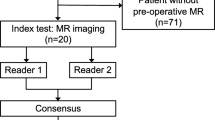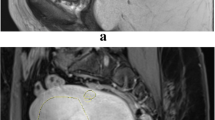Abstract
Purpose
To investigate the incidence of high T2 signal rims surrounding leiomyomas, evaluate if a particular T2-weighted sequence is more effective in depicting this rim, and determine if this sign is useful in differentiating pedunculated leiomyomas from other solid adnexal masses.
Materials and methods
In this retrospective study, two radiologists evaluated 233 T2 dark pelvic masses (223 uterine leiomyomas and 10 ovarian fibromas) in 60 women (mean age 47) on Magnetic resonance imaging for the presence of a high signal rim. Three different T2-weighted sequences were reviewed independently for uterine leiomyomas: half-Fourier acquisition single-shot turbo spin echo (HASTE), SPACE, and T2 with fat saturation (T2 FS). Only T2 FS images were available for 10 fibromas. A consensus review was conducted for discrepant cases. Statistical analyses were performed using Fisher’s exact test, kappa test, and ANOVA
Results
For 223 uterine leiomyomas, 23% (95% CI 17.8–28.9%) demonstrated a high T2 signal rim sign on T2 FS compared with 4.9% (95% CI 2.6–8.9%) for HASTE and 6.7% (95% CI 3.9–11.1%) for SPACE. The difference between the number of positive rims on T2 FS relative–HASTE and SPACE was statistically significant (p < 0.001). For ovarian fibromas, 40% (95% CI 16.9–68.8%) were classified positive for a rim sign.
Conclusion
A high T2 signal rim sign was present for up to 23% of uterine leiomyomas and the T2 FS sequence detected this rim sign most frequently. Up to 40% of ovarian fibromas can also have a T2 rim sign and, therefore, a solid adnexal mass with a T2 rim sign cannot be assumed to represent a pedunculated leiomyoma.




Similar content being viewed by others
References
Adusumilli S, Hussain HK, Caoili EM, et al. (2006) MRI of sonographically indeterminate adnexal masses. Am J Roentgenol 187:732–740
Saini A, Dina R, McIndoe GA, et al. (2005) Characterization of adnexal masses with MRI. Am J Roentgenol 184:1004–1009
Murase E, Siegelman ES, Outwater EK, Perez-Jaffe LA, Tureck RW (1999) Uterine leiomyomas: histopathologic features, MR imaging findings, differential diagnosis and treatment. Radiographics 19:1179–1197
Ueda H, Togashi K, Konishi I, et al. (1999) Unusual appearance of uterine leiomyomas: MR imaging findings and their histopathologic backgrounds. Radiographics 19:S131–S145
Hricak H, Finck S, Honda G, Goranson H (1992) MR imaging in the evaluation of benign uterine masses: value of gadopentetate dimeglumine enhanced T1 weighted images. Am J Roentgenol 158:1043–1050
Shinagare AB, Meylaerts LJ, Laury AR, Mortele KJ (2012) MRI features of ovarian fibroma and fibrothecoma with histopathologic correlation. Am J Roentgenol 198:W296–W303
Lee JH, Jeong YK, Park JK, Hwang JC (2003) “Ovarian vascular pedicle” sign revealing organ of origin of a pelvic mass lesion on helical CT. Am J Roentgenol 181:131–137
Torashima M, Yamashita Y, Matsuno Y, et al. (1999) The value of detection of flow voids between the uterus and the leiomyoma with MRI. J Magn Reson Imaging 8:427–431
Mittl RL, Yeh IT, Kressel HY (1991) High signal intensity rim surrounding uterine leiomyomas on MR images: pathologic correlation. Radiology 180:81–83
Asayama Y, Yoshimitsu K, Aibe H, et al. (2006) MDCT of the gonadal veins in females with large pelvic masses: value in differentiating ovarian versus uterine origin. Am J Roentgenol 186:440–448
Kim JC, Kim SS, Park JY (2000) “Bridging vascular sign” in the MR diagnosis of exophytic uterine leiomyoma. J Comput Assist Tomogr 24:57–60
Wilde S, Scott-Barrett S (2009) Radiological appearances of uterine fibroids. Indian J Radiol Imaging 19:222–231
Deshmukh SP, Gonsalves CF, Guglielmo FF, Mitchell DG (2012) Role of MR imaging of uterine leiomyomas before and after embolization. Radiographics 32:E251–E281
Conflict of interest
All of the authors have no competing interest and have nothing to disclose.
Author information
Authors and Affiliations
Corresponding author
Rights and permissions
About this article
Cite this article
Reiter, M.J., Schwope, R.B., Lisanti, C.J. et al. Can a T2 hyperintense rim sign differentiate uterine leiomyomas from other solid adnexal masses?. Abdom Imaging 40, 3182–3190 (2015). https://doi.org/10.1007/s00261-015-0510-0
Published:
Issue Date:
DOI: https://doi.org/10.1007/s00261-015-0510-0




